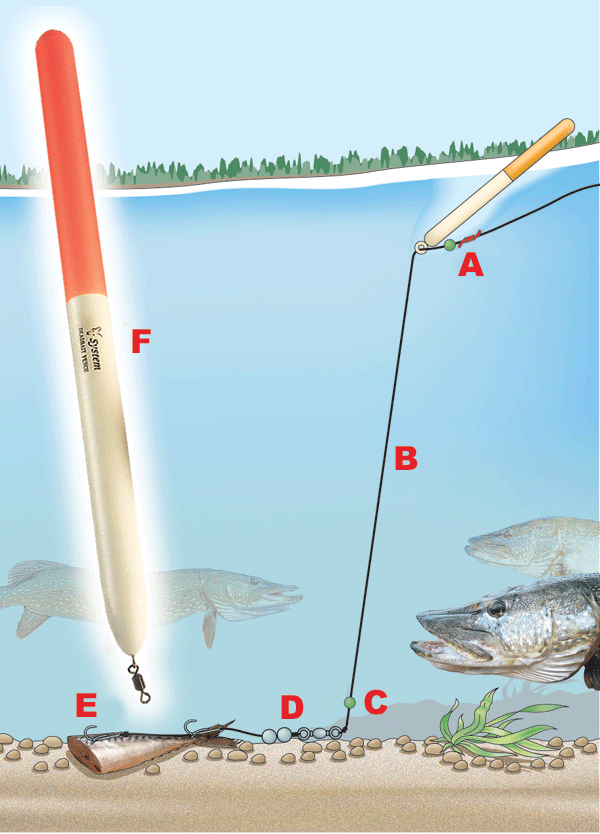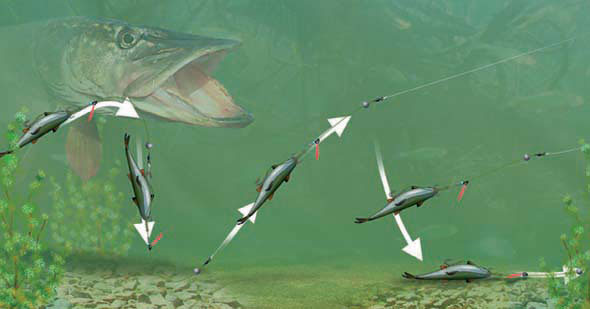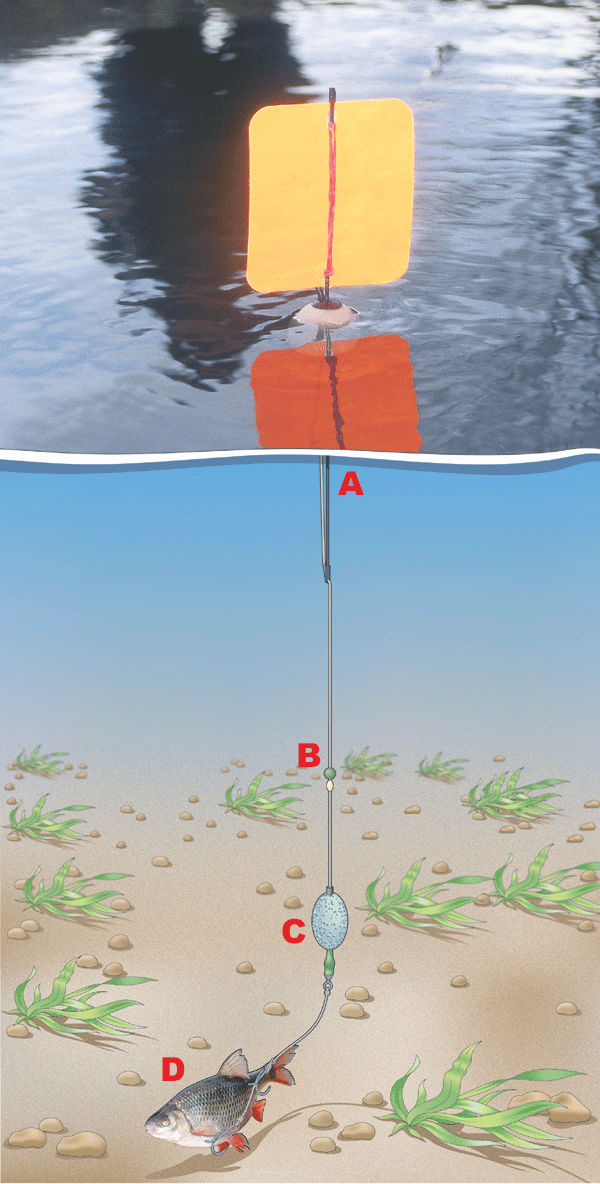How to tie the Carolina Rig
A: The action of the nose cone hitting against the glass bead on the retrieve makes a tapping noise which can induce a take
B: The leader section enables the lure to flutter to the lakebed under its own weight, which can encourage more bites
C: Because the hook point sits flush to the back of the lure, it is impossible for it to snag up in weed
When faced with a weedy river swim this lure set-up is almost impossible to snag up and is great for big perch....
Originally developed by bass anglers in the USA, the Carolina Rig has proven just as deadly for perch on this side of the Atlantic.
Designed to fish a soft plastic ‘creature’ bait close to the bottom and among thick weed, the Carolina rig has the great advantage that it is almost snagless.
This is because of the special wide gape offset hook that is used, and which are now available from several specialist lure outlets in the UK.
With the hook sitting flush with the top of the bait, this rig can be fished amid plants and sticks with little chance of snagging.
The Carolina rig is fished with a slow lift- and-drop retrieve that enables the soft plastic bait to wiggle enticingly as it moves forward and then flutter weightlessly down as the retrieve is paused. This action is very effective for perch and can also be used for zander too.
While drop shotting is rightfully very popular, other tactics such as the Carolina rig are great alternatives and well worth adding to your repertoire.
HOW TO TIE IT
1. Cut off a 24-inch length of 8lb fluorocarbon line to make the hooklength. Hold on to both ends and pull to straighten the line
2. Tie on the offset hook using a four-turn grinner knot. With fluorocarbon, only one pass through the eye of the hook is required
3. Tie a mini swivel to the other end of the hooklength using a four-turn grinner knot. Wet with saliva before pulling tight
4. Slide a 10g-15g bullet weight on to the mainline braid and follow with an 8mm glass bead. Tie braid to the swivel with a four-turn grinner
5. Thread the hook through the head of your creature bait and then back through the body so that the hookpoint lays flat against the back
6. A striking fish pushes the hook through the bait exposing the hookpoint, yet the lure will glide effortlessly through snags and weed
Float deadbait rig for pike and zander
This rig is ideal for both pike and zander, close in or at long range. It is very simple to create and can be used in water of all depths as the float is not locked at a specific depth - it slides along the line until it hits a stop knot.
A Use a powergum stop knot followed by a bead to prevent the float from sliding all the way up the line. This rig works best when the float's depth is set deeper than the water, eg set the rig to 12ft deep when fishing in 8-10ft of water.
B Mainline needs to be at least 12lb breaking strain. This rig is best used with mono rather than braid.
C Use a bead here to prevent the sliding float from hitting the knot and the wire trace, potentially damaging it upon the cast or when playing the fish.
D Place enough large split shot upon the wire trace to anchor the rig. You may need 3SSG shot at least.
E Mount the deadbait tail first and cut off the fish's head to ensure that the juices escape, adding attraction to the bait.
F The best float to use when fishing with this rig is a straight balsa, often referred to as a pencil float. Avoid using loaded pencil floats as they simply are not sensitive enough to provide instant bite detection.
How to catch more pike by wobbling deadbaits
If you learn how to wobble a deadbait you can put yourself in a prime position to catch many more pike and zander from lakes, rivers, canals and drains. It is a deadly technique that predator anglers use to great effect...
All too often predator anglers will mount their deadbaits upon their pike rig, cast it out and sit for hours on end waiting for that drop-off to fall, the alarm to scream or the float to go under. Meanwhile, there could well be a double or even a twenty-pounder making its way around the marginal shelf, seeking the odd roach or two to eat, and that’s an opportunity not to be missed.
All you need is your pike rig, a full-bodied deadbait, a large split shot and that’s it!
Tie your pike rig to your mainline and pinch the split shot (an SSG or a few AA is ideal) onto the swivel end of the wire trace.
Mounting the deadbait needs to be done head first. Push one hook of the mid-trebles through the bottom lip of the deadbait and out of the top lip. Now work the bottom-most treble into the flank of the deadbait. And that’s all you need to do.
The split shot upon the line will help sink the deadbait when you stop reeling in, and a gentle flick of the rod tip will see the bait shoot upwards or sideways. Continue doing this – reeling, resting and flicking – and you’ll make your deadbait look just like an injured food fish. And that’s pretty hard for any nearby pike to ignore.
The best baits for wobbling are freshly killed trout because they wriggle and bend as they are flicked. Other great wobbling baits are long eel sections, herrings, roach and smelt. Mackerel are often just too large for wobbling.
Popped up leger rig for pike and zander
The No1 rig when legering for pike or zander! It's easy to create, it's easy to cast, it's virtaully tange-free and it provides absolutely excellent bite registration.
It features a very long paternoster link that has a large bomb and one end and a large diameter swivel at the other.
All you need to create this rig is a 2-3oz bomb, some spare 10-12lb mainline, a large swivel, a large bead, your pike trace, some spare pike wire, a couple of Bait Poppers, wire cutters and a pair of forceps.
Firstly, you will have to attach a couple of Bait Poppers to your wire trace to ensure that the deadbait is lifted off the bottom and away from any weed.
Now cut off a 2ft length of 10-12lb mainline and tie it securely to your heavy leger bomb. Next you will need to tie a large swivel to the other end. This link needs to be at least 6in longer than your wire trace, so measure it first before tying on your swivel.
The best knot to use to tie your swivel and bomb to the line is a grinner knot.
Thread your mainline through the eye of the link's swivel, and then through a bead. Finally attach your pike rig onto the end of your mainline using another grinner knot.
This rig casts really well, plus you can see whether it has become tangled throughout the cast. It's best to swing the lead around the wire trace before casting so that it rotates immediately before casting. This will keep the trace hooks and the leger link separate and therefore tangle-free.
A - use a heavy 2-3oz lead
B - a 10-12lb mono link is perfect
C - popping your deadbaits off the bottom works best
D - a large swivel followed by a bead minimises resistance to a taking fish
E - use 12lb mono or 30lb braid as your mainline.
Drifter rig for catching pike at range
This is an absolutely deadly rig to use when pike fishing in a breeze. It can be used with dead or livebaits and can catch pike well out of casting range, and also catch pike from areas of lakes that are otherwise inaccessible to bank anglers. The best float to use is a Fox Drifter Float - they are perfect for the job.
A Use a floating braided mainline when drifter float fishing. The braid should be 30lb breaking strain as a minimum. Using braid ensures that you gain direct contact with the rig upon the strike, even when fishing 100 yards from the bank. The float needs locking to the required depth by using a powergum stopknot followed by a bead.
B Place a bead under the drifter float to protect it from the weight further down the mainline.
C Use either a series of large SSG split shot or a Fox Egg Sinker to cock the float. You will find Egg Sinkers in sizes to suit the size of the float body you wish to use.
D Whether you decide to use a live or a deadbait, they both should be mounted upon a wire trace using two sets of treble hooks. When using a deadbait, make sure you mount it in the same way as you would a livebait, so that the fish hangs horizontally and not vertically (which looks unnatural). One final point - set your rig so that your bait is positioned well off the bottom and away from any bottom weed.












